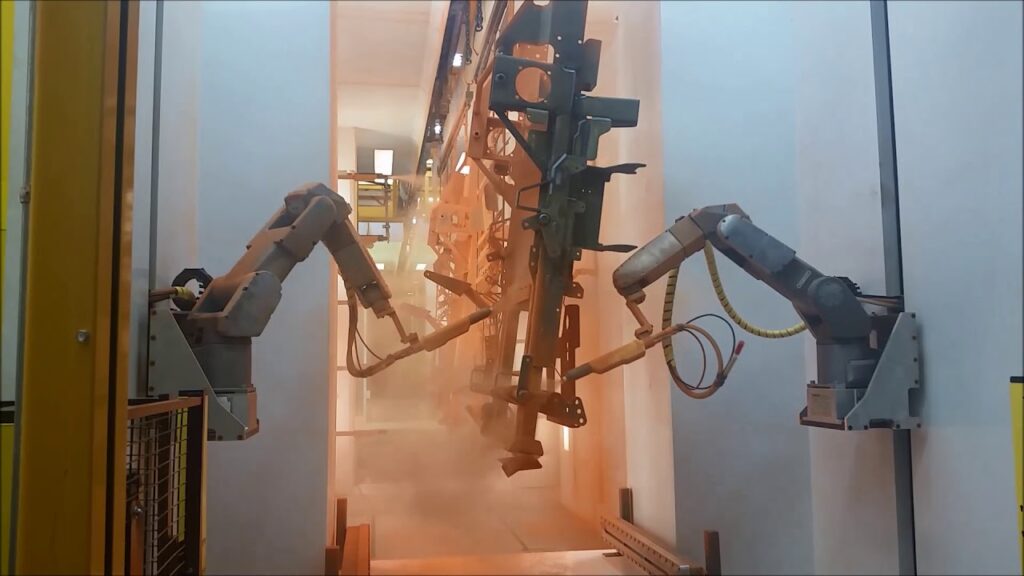-Industrial Automation Robots Transforming the Painting Industry-
In the realm of manufacturing, automation has proven to be a game-changer. One area where this is particularly evident is in robotic painting systems. Gone are the days of painstakingly painting each product by hand, as industrial automation robots have revolutionized the way we approach this task. In this article, we will explore the integration of four Fanuc Paint Mate 200iA robots into an existing GEMA paint system, utilizing the “Two Pass Powder” technique.
Painting is an essential part of the manufacturing process, and achieving a consistent and high-quality finish is crucial. Traditionally, this has been accomplished by skilled painters who meticulously apply coatings to each product. However, this approach is not only time-consuming but also prone to human errors such as uneven application or overspray. This is where industrial automation robots come in, providing a reliable and efficient solution.
MWES, a leading provider of automation solutions, recently integrated four Fanuc Paint Mate 200iA robots into an existing GEMA paint system. This integration marks a significant advancement in the industry, as it combines the capabilities of both the robots and the system to enhance the overall painting process.
The GEMA paint system itself is renowned for its “Two Pass Powder” technique, which involves applying two separate layers of powder coating to achieve a flawless finish. This technique ensures excellent adhesion, even coverage, and durability of the coatings. By integrating the Fanuc Paint Mate 200iA robots into this system, MWES has taken the painting process to new heights.
The Fanuc Paint Mate 200iA robots are specifically designed for painting applications and offer exceptional precision and consistency. These robots are equipped with advanced vision systems that allow them to detect the shape, size, and orientation of the products being painted. This enables them to adjust their movements and apply the coatings with incredible accuracy.
The integration of these robots into the GEMA paint system has led to a significant increase in productivity and efficiency. With their ability to work at high speeds and precision, the robots can handle a higher volume of products, reducing the overall production time. Additionally, their consistency in applying the coatings ensures a uniform finish across all products, eliminating variations caused by human error.
Furthermore, the integration of industrial automation robots in the painting process has also improved safety conditions for workers. By removing the need for manual painting, employees are no longer exposed to potentially harmful chemicals and fumes. This not only enhances the well-being of the workers but also minimizes the risk of accidents and health issues in the workplace.
The impact of industrial automation robots in the painting industry extends beyond efficiency and safety. These robots also contribute to environmental sustainability. The “Two Pass Powder” technique used in the GEMA paint system significantly reduces the amount of waste generated compared to traditional painting methods. By ensuring a more precise application, there is minimal overspray, thus reducing material waste and environmental impact.
The integration of the Fanuc Paint Mate 200iA robots into the GEMA paint system serves as a testament to the continuous evolution of automation in the manufacturing industry. This case study exemplifies how industrial automation robots are transforming conventional processes, bringing forth improvements in productivity, quality, safety, and sustainability.
As we look ahead, it is clear that the role of industrial automation robots will continue to expand and revolutionize various sectors. The painting industry is just one area where these robots have made a profound impact. With ongoing advancements in technology and the increasing demand for efficiency, we can expect to see further innovations that will shape the future of industrial automation.
In conclusion, the integration of four Fanuc Paint Mate 200iA robots into an existing GEMA paint system has demonstrated the transformative power of industrial automation robots in the painting industry. This integration has not only improved efficiency and productivity but also enhanced the quality, safety, and environmental sustainability of the painting process. As automation continues to advance, it is an exciting time for the manufacturing industry, as we witness the limitless possibilities that industrial automation robots bring.
Industrial Robot
“Enhancing Efficiency and Precision: Exploring Robotic Painting Systems and Automation in Industrial Applications”


